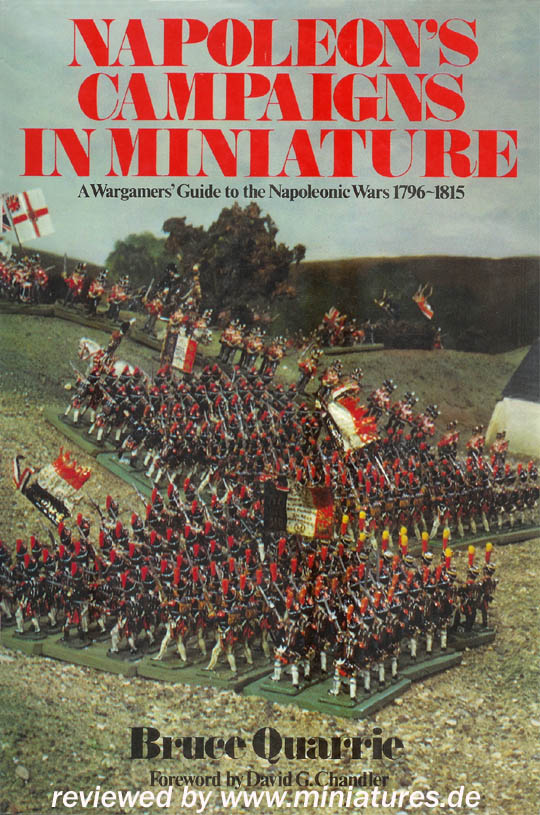Napoleon’s Campaigns in Miniature
A Wargamer’s Guide to the Napoleonic Wars 1796–1815

Published in response to popular demand as a result of Bruce Quarrie’s first book on Napoleonic wargaming (Airfix Magazine Guide 4), this title was planned as the first in a brand new series on refighting the campaigns of the great captains of history.
Described by David Chandler in his Foreword as achieving "the difficult integration of theory and practice, of the actual event and the table-top simulation", it begins by outlining the basic principles of wargaming and numerous hints on choosing, assembling and painting your own army of model soldiers. A concise account of Napoleon’s actual campaigns, well illustrated by 3D battle maps, is followed by sections on recruitment, wages and training, including population resources and national revenue; the organisation of the main armies of the period, including not only France, Britain, Austria, Prussian and Russia but also those of Spain, Portugal, Italy, the Confederation of the Rhine, Poland and Scandinavia, with notes on their fighting capabilities; lines of communications and supply, including the amounts of food and forage required for the maintenance of an army in the field, and their cost; leadership, with brief biographies of many of the major army commanders; grand strategy and battlefield tactics; the weapons of the period and their effectiveness; medical services, prisoners of war, attrition and desertion; siege warfare; and much more.
Finally, there is a chapter on setting up an actual campaign, with playing suggestions for movement movement rates, maps, time scale and the role of the umpire; and a completely revised, expanded and updated set of basic playing rules which have won widespread international acceptance from the author’s previous book.
Designed principally to make wargaming more interesting and realistic by relating the table-top encounter to its overall economic, political, social and strategic context, this is a book which no serious Napoleonic wargamer can afford to be without.
Contents
- Title: Napoleon’s Campaigns in Miniature
- Period: Napoleonic
- Type: Tactical Wargame
- Time Scale: one turn = 2.5 minutes (or 1 hour off table)
- Ground Scale: 1:915 (1 mm = 1 yard)
- Troop Scale: 1 figure = 33 men
- Firing Ranges
- 12-pounder: 1250 yards = 1143 m
- 8″ Howitzer: 1250 yards = 1143 m
- 6″ Howitzer: 1150 yards = 1052 m
- 5,5″ Howitzer: 1100 yards = 1006 m
- 8-/9-pounder: 1000 yards = 914 m
- 6-/7-pounder: 950 yards = 869 m
- 3-/4-pounder: 900 yards = 823 m
- Musket: 200 yards = 183 m
- Rifle: 300 yards = 274 m
- Carbine: 175 yards = 160 m
- Carbine (mounted): 150 yards = 137 m
- Author: Bruce Quarrie
- Format: 192-page rule book
- Language: English
- Publisher: Patrick Stevens Ltd., Cambridge, England
- Published: 1977
Chapters
- Essential ingredients of the Napoleonic wargame
Scales, frontages, simultaneous movement, orders - Choosing, painting and mounting figures
Options, research, plastic or metal?, priming and undercoating, mass production, horses, choice of paint, brushes, bases - Chronology of the Napoleonic Wars
Italy 1796–7, Egypt 1798–99, Italy 1799–1800, Ulm and Austerlitz 1805, Prussia 1806, Poland 1807, Spain and Portugal 1807–9, Austria 1809, Spain and Portugal 1810–12, Russia 1812, Germany and Spain 1813, abdication 1814, the Hundred Days 1815 - Recruiting and paying for an army
Economy, taxation, subsidies, population, resources, the British army, bounties, militia, officers, scaling down, equipment costs, foreign exchange rates, campaign requisites, cost of small-arms, price of horses, training, rates of pay, cost of artillery pieces - Organisation
Infantry, cavalry and artillery, France, Austria, Russia, Prussia, Britain, Spain, Portugal, the Confederation of the Rhine, Poland, Italy, Naples, Scandinavia - Lines of communication and supply
Contractors, roads, vehicles, magazines, food requirements, weights, prices, clothing, prices, ammunition, weights, prices, gunpowder, caissons, draught animals, fodder - Medical services and prisoners of war
Diseases, wounds, amputation, Baron Larry, the “flying ambulance”, organisation, hospitals, administration, in wargames, dead and wounded, convalescence, prisoners, guards, exchanges - Attrition and desertion
Strategical consumption, numbers of desertions, reasons, in wargames, stragglers - Generals and generalship
Leadership qualities, biographies, Austria, Britain, France, Prussia, Russia, commanders in wargames, ratings - Weapons and firepower
Muskets, drill, range, accuracy, bayonets, artillery types, drill, rates of fire, the playing rules, determining casualties, roundshot, cannister, shell, shrapnel, tactics - Strategy and tactics
Aims, influences, manœuvre sur les derrières, bataillon carré, strategy of the central position, planning, intelligence, dispersion and concentration, infantry, line and column, cavalry types and usage, infantry squares, the “ideal” battle - Sieges
Types of siege, fortifications, siege tactics, trenches, mining, artillery, sallies, street fighting, in wargames, blockades, assaults, formal sieges, casualties - Setting up a campaign
The campaign diary, suitable maps, movement rates, weather, roads, cavalry screen, role of the umpire, messages, from map to table, foraging, purchase of supplies, elevation of troop status - Playing rules
Scales, unit frontages, orders, visibility, rain, mist, wind and smoke, dead ground, national characteristics tables, movement, changes of formation, control, small-arms and artillery fire, ranges, deductions, special artillery rules, casualty charts, morale, definitions, melées, additions and deductions, buildings - Weather
- Calendars
- Field engineering
- Select bibliography